Every once in a while I’ll get an email from someone who wants to know. “Whatever happened to that graphic novel you were working on? Did you ever finish?”
Discards. I worked on it for four years, completed more than three hundred pages while working full-time as a high school art teacher. And now it sits in a box in my closet, unread by all but a few friends, several of whom largely hated it.
What went wrong?
I’m still a teacher. I look at the pile of effort and time and in the right light I see something that might be useful to another cartoonist. I did after all make it that far. Hundreds of pages of finished comic art is in itself nothing to sneeze at. And there’s no doubt in my mind that those hundreds of pages, along with my high school teaching, brought me the skills that I have today, skills that employ me as a freelance illustrator, even if my cartooning itself isn’t in much demand these days.
I was twenty-six when I started, a high school teacher with an almost fevered desire to work, to make things, to bury myself in the aspects of my life I could control. For several years, making Discards provided me with the focus I needed to forget all the other things in my life that were making me miserable.
But somehow, of all the projects I’ve been involved in, this was the one I was unable to drag across the finish line. What went wrong?
But first —
What Went Right
There are reasons I got as far as I did, things I did that I would recommend to anyone pursing long-form comics. For one, I wrote a script — multiple drafts, in fact. The story started out as prose, a manuscript called The Three Thrift Kings. On second revision it lost its title along with most of the text, and became Discards.
The first draft was a loosely interconnected set of stories largely set at a thrift store in rural Florida. The protagonist Michael (I know, I know) has returned to his childhood home for unspecified reasons and takes a job as a janitor at a thrift store. It’s a sort of Pilgrim’s Progress, in a retail outlet, with drugs and lots of monologues about video games.
As a first draft, the story was a structural mess. I had written it as a receptacle for a series of autobiographical anecdotes about my time as a janitor, back-up man, and finally furniture-electrical pricer at a large thrift store in Casselberry Florida. The smaller nested anecdotes were stories I had refined over a long period of story-telling, but the central plot that linked them all together had been grafted on later in the process. (This too was a “found” element. After talking with a fellow teacher about all the strange things I had encountered working at the store, he told me about one of the strangest jobs he had ever worked — cleaning out evicted properties. His story of finding a stash of drugs, and the subsequent return of the owner of said drugs, would provide the missing through-line necessary to make a coherent story out of first draft.)
The second draft refined the physical environment of the story until it took place in essentially two locations– Michael’s house, the thrift store, and the walk between the two. It also strengthened the main events of the narrative by introducing those strands of plot earlier on. In short, it was structurally sound, something that would have been impossible to do had I tackled the pages graphically directly from the onset.
The setting for the story was visually rich as well, and I knew that my intimate knowledge of the minutia of the environments I would be describing would make for interesting comics.
After completing the second draft of the script, I made my second smart move – I drew layouts for the entire book.
Years of studying page mechanics, and the two or three hundred pages I had drawn in my life so far, meant that the layouts came easily, once I warmed to the task. After some initial slowness, I worked my way up to a speed of about 20 pages of layouts a day, working on sheets of discarded paper folded in half, mainly to discourage myself from feeling too precious about my drawing.
In fact, the faster I worked, the better things seemed to go. If I got bogged down on a page, trying to figure out the spacial mechanics of a scene or movement of the characters or placement of dialogue, I’d just crumple it up and continue on another sheet. After a few days of this my layouts were getting much stronger, even as my drawing itself got looser and looser. By the end of the month I had laid out the entire 400 page book.
Not having a final length in mind led me to expand and contract sections at my own whim, and I brought an almost perverse joy to extending certain sequences that had in the script been only a sentence or two of description. Other scenes were recast dramatically, especially dialogue-heavy scenes, which often had added physical action as my “actors” took over from my writer.
And if this were a happy article about personal fulfillment and artistic success, this might be where I would end, with the satisfied artist and his stack of folded copy paper, a readable story in his hands mere months after first imagining.
But I’m afraid that’s not what happened.
What Went Wrong
What am I looking at, and why do I care? Discards, page 25
A. Millions of Tiny Little Lines/ Working Too Large
When I started Discards, I had some experience in pen and ink, with a wide variety of tools and textures at my command. But I had virtually no experience working for reproduction. By the time I had drawn my first 50 pages, it was clear two things were already very wrong.
For one, I was working at a scale much too large to be useful for me. Specifically, I was working with an active page area of 11” x 15”, i.e. double the size of my folded letter-paper layouts. Huge originals plus a mania for tiny little lines and an initial fear of bold application of blacks equaled pages that seemed anemic and washed-out, no matter how many layers of lines I added.
And all those little lines added precious time to each page. My work sessions took place every day after ten hours of teaching. I timed them. Each page was taking between 10 and 15 hours to complete, the majority of this time spent embellishing. “Well, you’re fearless, aren’t you?” cartoonist Jim Woodring told me once, staring at a page consisting of nothing but shopping carts in a darkened room. I don’t think he meant it as a compliment.
B. Shifting Designs
Even worse than the huge amounts of largely invisible effort was the waste caused by ineffective designs or “off-model” characters.
Somewhere, some when, some genius said it first. “In comics, style is way less important than consistency.” Whomever it was, I’d like to shake their hand, and then ask them to please build a time machine and head over to Seattle circa 2009 so that they can let me know in person.
My initial designs for my characters just weren’t very well-thought out. They weren’t easily distinguished from each other, not by body type, not by facial structure. And as a consequence of that initial failure, I just kept on tweaking even as I produced “finished” pages.
The result of this was a stylistic mishmash, where characters were sometimes only identifiable by the type of screen-tone applied to their hair. Had I applied some basic rules of design to differentiate them from each other at the start, it would have saved me a lot of grief.
This “design drift” was made even worse by the rudimentary nature of my cartooning. As an observational draftsman, I had some skills to draw upon at the start of the project, but as a cartoonist producing stylized forms from my imagination, I had a lot of work to do. And the better I got at these tasks, the more inadequate the previous pages seemed to my eye.
The crudity of the drawing was made worse by the surface polish of the inking and rendering.
Sylistic drift of this kind would have to be very dramatic to be visible over the time scale of, say, a ten page or even 25 page story. But a graphic novel is one contained unit. You can hold it in your hand, flip through it, stick your fingers between the pages. The first panel exists with the last in perfect simultaneity, no matter how much time passed in the process of creation.
This is not unlike the difficulty of assessing the work of, say, Dave Sim and Gerhard and their 26-year project Cerebus. The early issues of Cerebus, crude as they could be visually, still stood unified stylistically as they appeared, issue by issue. But as collections, the early work reads very differently. Much of this difference is undoubtedly due to this stylistic drift. What was an asset in the serial format (improvement of the artist over a prolonged period of time) becomes a liability when the format is changed.
Had I been publishing or otherwise making these portions of Discards publicly available as I worked, it’s possible that I would have been able to make peace with the early portions of the book. But as it was, unseen by anyone save my fellow Seattle cartoonists, the early pages shortly seemed unbearably crude to my eyes. And the more I developed, the wider the “awkward” phase of the book seemed to be.
“Be like a shark,” cartoonist Jon Morris tried to warn me. “A drawing shark. Don’t stop swimming. Just keep eating stuff.” And had I been working on a series of short stories, something where each unit could be its own contained unit, then I might have persuaded myself he was right. But this was a novel, dammit. Shouldn’t the first page look like the last?
C. Didn’t You Know What A Jerk You Used to Be?
The real end to all of this wasn’t my frustration with my drawing, or the labor of the large-format pages. I actually managed to correct course on both of these problems mid-way through the book, switching to a much smaller scale, working with more dramatic blacks and incorporating bold brush into some pages, and finally settling in to drawing the characters with an acceptable amount of consistency.
What finally sunk it was this – so much time had passed since the initial idea, I hated the whole story.
It was two cartoonist friends of mine, David Lasky and Helen America, that gave me the bad news that I was making a book about an asshole. He’s completely unlikable, they each told me over tea and cake. Why should we care about him at all?
This was a hard blow. I was, after all, in the process of making a story about someone who possessed many of my memories and experiences, if not always my actions or personality. How could they say something so harsh about him? About me?
And then, with their reactions in mind, I sat down and read what I had made.
I hated him.
Really, I hated me.
Here was a story about someone who is essentially a tourist in the lives of the people around him, who observes them from the comfortable distance of condescension. Several of the choices I made as a cartoonist reinforced these distances – the facial caricature, the dialect. Here, truly, was a book about a brash young man who is in fact an asshole. Who happened to have been based, at least partially, on myself.
I tried a few fixes, specifically, adding a sequence in the very beginning that gives the character some self-awareness of these deficiencies, letting the audience into his thought process a bit while introducing hints as to the events had shaped him into the person he was.
But it was too little too late. The project was definitively killed a month or two later, when I had my first taste of being paid to make things I was interested in. My labor was done, although Discards never would be.
What’s The Point Here, Anyway?
When I think about my brief time making comics for public consumption, I’m struck by the oddity of it all, that my most widely-read comic written and drawn in a single twenty-four hour period, was not labored over in any way at all. How different would my cartooning have been if I had used all the time I spent on Discards making other short, spontaneous comics instead? How many thousands of pages might I have now had I focused on content rather than the pursuit of some awkward perfection?
Of course, who knows what those comics that never were might have been like, and what kind of things they might have said about who I was at that time. Although the unfinished things in our lives can be painful, in some ways it’s the finished ones that are the worst, in that our failures are so clearly articulated by our own labors.
For me, finally, I’m happy for Discards to finally be what it is, a journeyman work in a box in a closet. A personal example of what can happen when you want too much and know too little. And, maybe, an example of how not to make a graphic novel.
Sean Michael Robinson is a writer, illustrator, and musician. You can contact him at LivingtheLine.com, or at seanmichaelrobinson at gmail dot com.


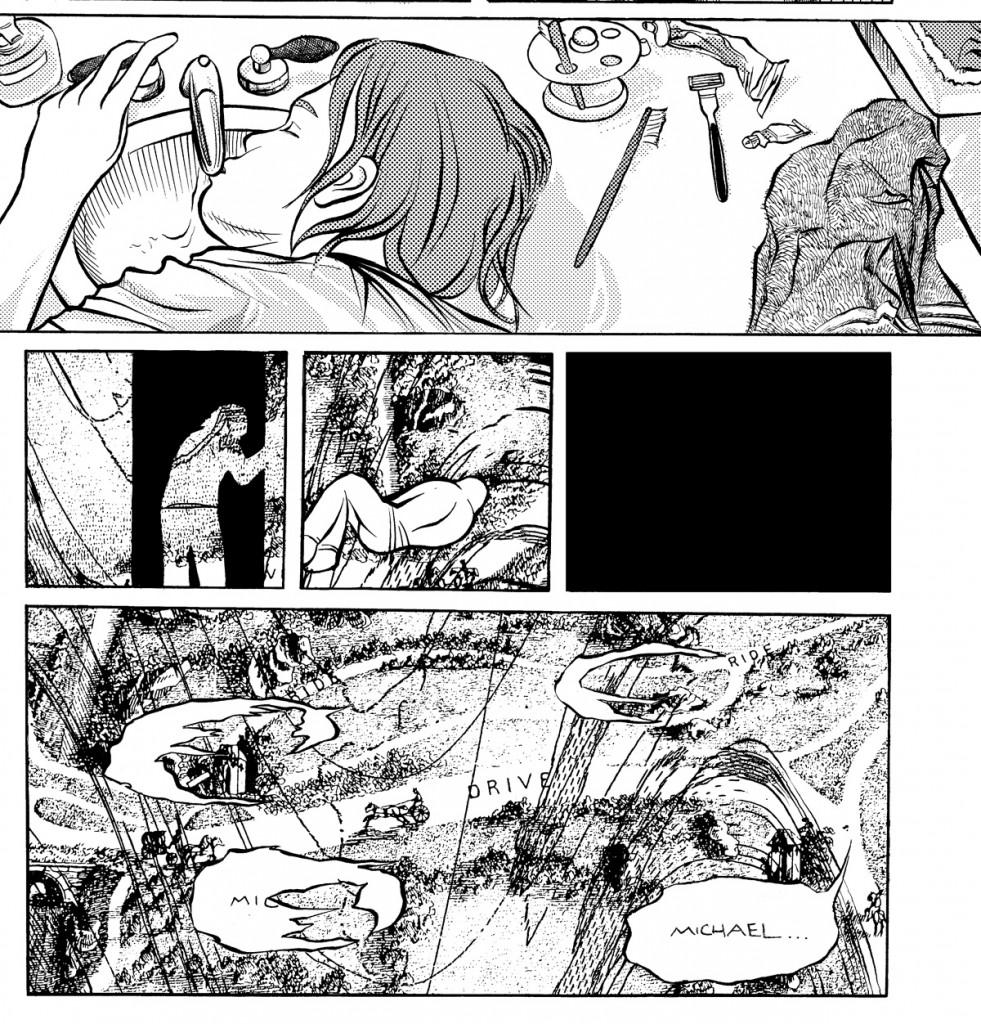

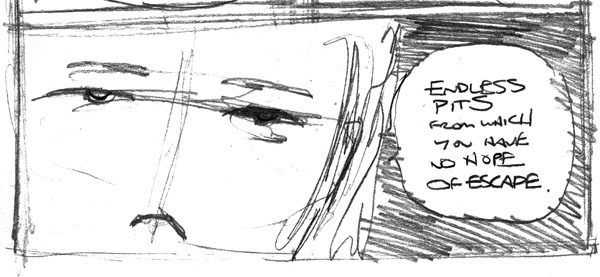
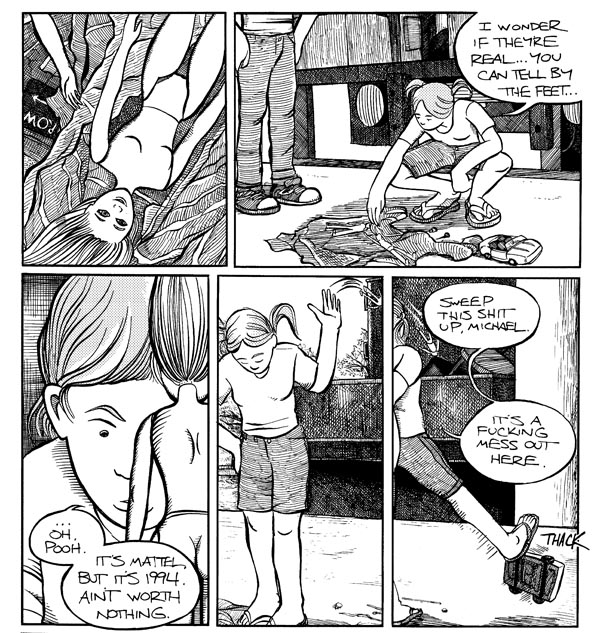
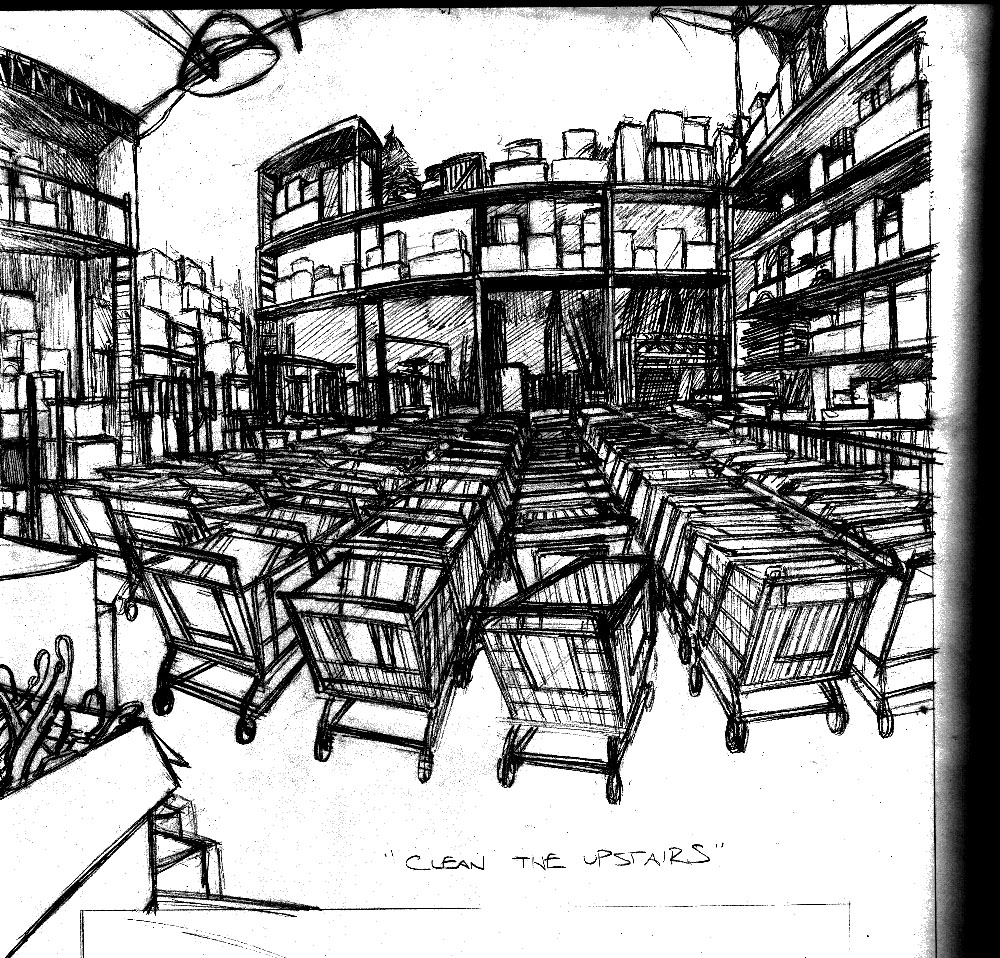
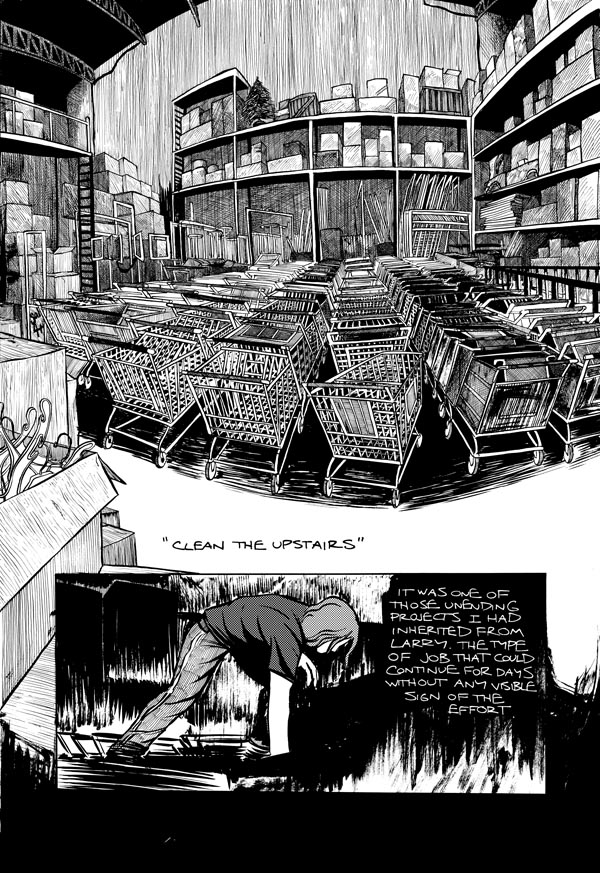
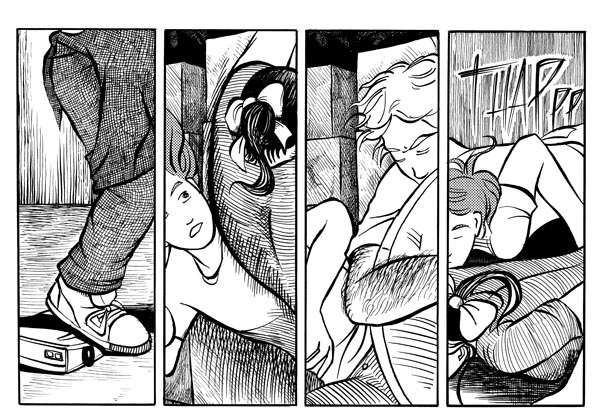
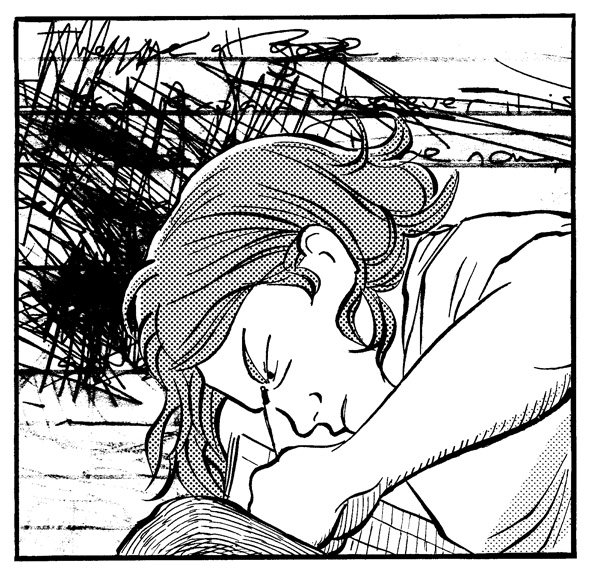
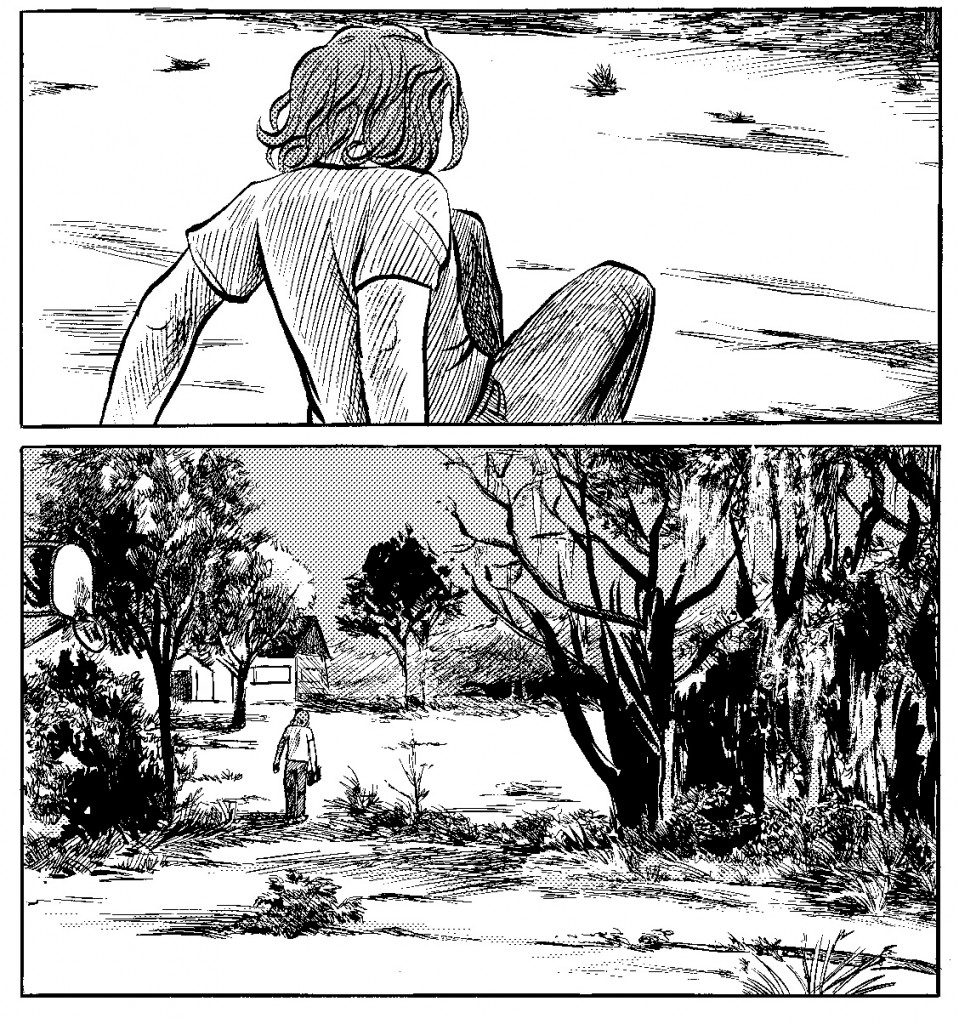
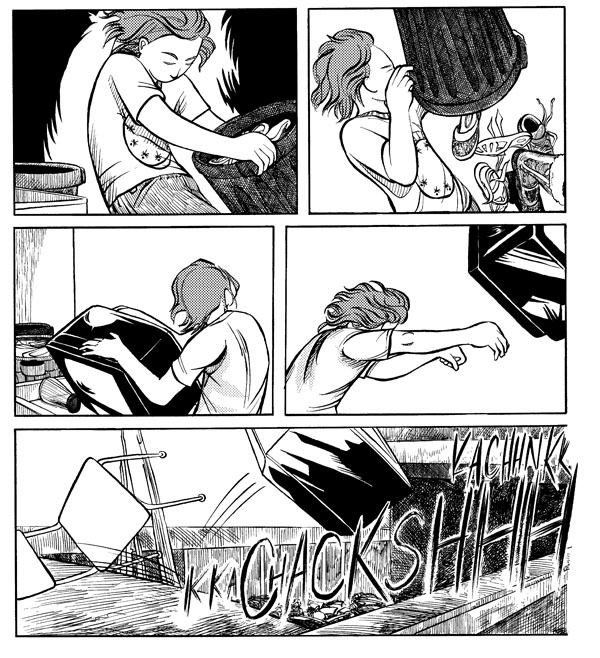
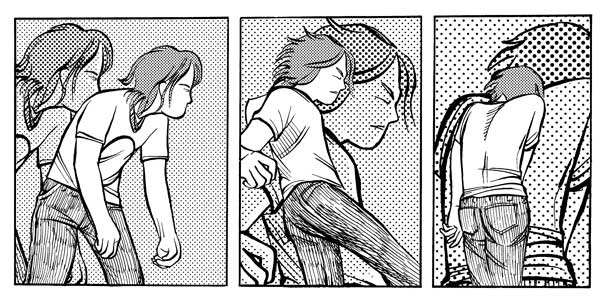
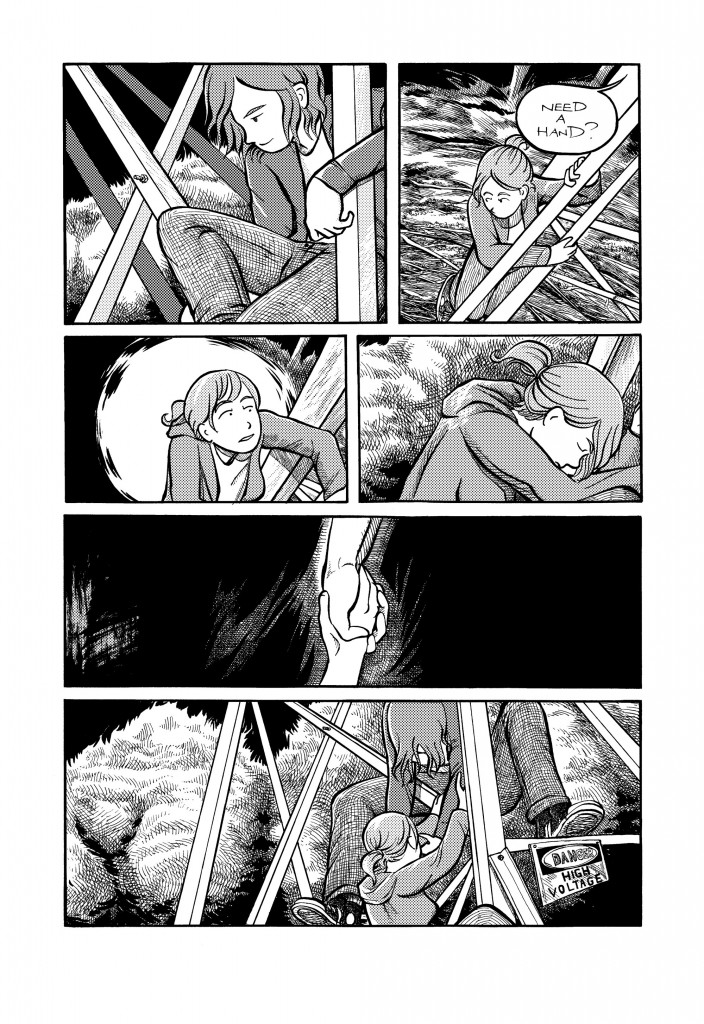
Put ‘er on the interwebs. No matter how shitty you think it is now you probably produced a comic of better quality than the majority of webcomics put online.
Quite a cri de coeur, Sean. And pretty gutsy too, it’s hard to wash your linen in public. If we all posted our comix failures, it would be a pretty grim sight … maybe a good idea for HU … a collaborative Wall of Shame?
I loved the shopping carts page, really nice work … and there’s two reasons why Woodring was so bemused … complex line work is trickier than it looks to make those lines look just right, not too spindly or too “blowsy”. The first step to doing pen and ink is doping out the page size, the line widths depend on it.
And although the public loves complex, slow line-work, publishers seem loathe to pay for it. The fast cartooney style sells for a reason — it’s cheap to execute and cheap to purchase. And as it’s used more and more for all illustration work, cheap to look at.
And yet artists constantly get feedback from the more enlightened publishers and general readers that the more detailed, realistic look captures the eye better …
Slow drawing … the slow food of art.
Thanks for this remarkably honest and generous account of what happens when the story you WANT to tell isn’t the same as the story you need to tell.
great article and insight! Don’t put Discards on the web, in your closet, it’s an empowering functional thing you’re getting something out of, actually, it’s even inspiring me as it is now. In its current context it’s a finished object, exposed an unfinished story that never arrived at “the good parts”. You intended your carefully-wrought beginning pages to serve as a foundation for great and fantastic leaps, and metaphorically, it has done just that!
Thanks for sharing you experience with us, Sean. As an amateur cartoonist who has a couple graphic novels floating around in his head, this was very very useful to read!
Excellent article, thanks for sharing this, Sean!
William —
>>Put ‘er on the interwebs. No matter how shitty you think it is now you probably produced a comic of better quality than the majority of webcomics put online.<<
Er, thanks? ;) Not sure if that's really an endorsement.
Mahendra,
Thanks for the kind words! It was definitely interesting flipping through these pages to find samples for the article. My “eye” has definitely changed a lot over time, and a lot of that has been from embracing techniques that are a lot less fussy, though I’m still up for some fussiness in the right circumstances. Using big damaged brushes has been my most recent breakthrough, kind of willfully circumventing my own polishing tendencies through choice of tool.
Sharon–
>>when the story you WANT to tell isn’t the same as the story you need to tell.<<
That's a wonderful way to put it. Thanks for the kind words.
So it sounds like (from my distant point of view) that it didn’t pan out as the awesome story you wanted it to be, but that it helped you, in some way, grow as a person.
Still a victory.
You’re welcome, Sean. Fussy’s not for everyone and that’s one of the big things about developing one’s eye and hand: you draw (and learn to look) better once you accept your own congenital tastes and impulses.
And in the end, style and technique exist to be thrown away, but only after completely mastering them. A stage which very few, if any of us, will ever reach.
Big damaged brushes? Great name for a rock band!
Billis–
That means a lot to me, especially coming from you. Thanks so much. (Billis is an amazing cartoonist. Watching him draw, directly in ink, no less, is like watching someone write a letter or something. Just lines oozing out of his fingers.)
Mahendra-
It’s not like I dislike fussy! I just get sucked in, and start focusing on all of these tiny things that don’t matter, instead of, you know, getting my drawing solid in the first place. A lot of this was about learning to circumvent those controlling tendencies within myself.
Is there a necessity to like the main character?
Came here from Scott McCloud’s twitter feed. This is a really fantastic, thoughtful, helpful, inspiring article. Thank you for taking the time to beat yourself up in public :) but seriously, it’s unimaginably hard to look back at your past and your old work, much less share it with everyone. I admire your focus in being objective AND productive about it. I’d also love to see Discards, though I totally understand sometimes a creator just feels like they never want something to see the light of day again, and knowing that it exists and you made it is enough.
There were lots of words of wisdom and gems in your piece about attitude and approach in comics storytelling that I really appreciated. I’ve made short works (and amusingly enough one of the things I think has been most successful so far in achieving what I wanted was also a 24 hour comic). I long for, and struggle with finding, the ability and discipline to put together a cohesive, engaging, longer narrative. It’s a difficult balance not getting caught up in trying to include everything that you think a “perfect” story needs, avoiding making something overwrought … Anyways, enough blabbing but the sum of it is, thank you for writing and sharing this!
The art you posted here looks really good, seems a shame to toss all of it. Any chance it could be salvaged with a rewrite? Even if you just get a short story out of it?
Tom Brevoort said Roy Thomas pulled of a brilliant rewrite of a bad story George Perez had drawn for JLA/Avengers :
“First off, everybody on the Marvel end–including DeFalco, Gruenwald and Roger Stern–agree that Roy Thomas did an incredible job in reworking the original plot in such a manner as to make it all make sense while still incorporating virtually all of the pages that had already been done. DeFalco in particular referred to Roy in this instance as “a magician”, and even expressed a tinge of professional jealousy that another writer could pull something like that off.”
“http://www.jimshooter.com/2011/07/secret-origin-and-gooey-death-of_22.html?showComment=1311395881371#c202606161888886985”
At any rate I’m sure you’re a much stronger creator for having gone through the process!
Osvaldo–
The problem is, the story structure depended on you caring about or being interested in his thoughts, feelings and observations. If I had set out to make a story about someone unlikable, I would have pushed it further that direction, intentionally, and heightened those tendencies.
In high school I had an art teacher that once told me, “if that’s supposed to be sloppy, then it needs to be sloppier. If it’s not, then straighten it up.” I think this might apply to likability as well.
Pallas– a fine idea. I don’t think I have the heart for it (I’d rather work on something new!) but I’ll give it some thought.
Maiji,
Thanks for the kind words! Really glad it could be helpful to someone.
Sean, thanks for writing this. Being years into and yet only about 150 pages in on my own graphic novel, I related very much to every word you wrote here. I’m not giving up just yet but I’ve run into every single problem you mentioned here myself.
This a gift. I am sure many of us reading this come to it with personal comparable paths. Each unique, but all informed by your story.
In two very important ways you are distinctly more successful then myself. One you had a process that was heavy in the preparation and final out put. Secondly, you had a teaching job. My decades old dream still at age 38, is to teach art by day and Cartoon by night. I have had a teaching lisence since 2008, which took me 5 years to acquire (not for lack of Academics). Prior to that I taught Comics in a college, fresh out of back to back BFA/MFA comics School (where I had my own brief face to face with Jim Woodring; nice guy). Where is my day job? In medicine. Great job, I am good at, but I am not utilizing my “real” talents or interests. As to making Comics. I produced a floppy Comic right after college. My work throughout school had that same reseption you describe (all my own fault), and the self-published Comics was no different. Let’s just say, James Sturm was not the biggest fan of my work, but I took a lot of his classes. I was not the worst in any class, but it was always clear there were a handful of students that were going places and I was not one. Thing is, I had been on this road since age 4. I only really know one subject, “Comics.” Everything else I am OK or disabled in. So after my book flopped and my friends from school were grinding out a career in Comics, I felt paralyzed. I focused on the day job in medicine, building a family, and getting that teaching job (which I felt and feel I have talent for…more than Comics). Then with the encouragement of friends like Ben Towle, Max Clofelter, Robyn Chapman, Ben Phillips, Zak Kinsella and especially Kelly Thompson I just started making Comics when I had time and an idea. It still took me forever to realize I really should not bite off more than I can chew. Each time I though something was along piece of work, serving a non existent audience, I would loose interest. Which is why your story is so remarkable to me. I am blown away by anything longer than a page at this point. However, I try to rap each project up and remain committed to the form. Within the next couple years I will have enough of this work to share in a one person anthology (like Clowes…but as Towle would say…not nearly as good). I personally like everything I have done since 2009 (some earlier stuff too). I hope an audience forms around my lack of commitment to a long narrative or a refined singular vision and voice. It may never happen, but I can’t stop.
I hope you take the ideas at the end here and start making one page or a few page comics. I don’t think any of us do this for money (or we shouldn’t be think crazy like that). I don’t think it really should be or often is about ego (that’s a Hollywood approach to visual art storytelling). I do think we do it for all kinds of personal reasons (maybe those other two work well for others…and it’s just me). Mostly though, if you like doing it and can make it effortless…go for it. What do you have to loose? There is something you made, that says something to you…and maybe to others. Who knows?!
In the end, most people either draw for money or for what’s called self-expression … each path has its merits and pitfalls. Or you can be completely nutters and draw for eternal glory.
Learning how to rip your own work to shreds and toss it in the trash is a huge step forward. Self expression without ruthless, critical self-analysis is a waste of time.
Hey Ben,
Thanks for the thoughts. (If anybody needs confirmation of how tiny the comics world is, keep in mind of his list of five cartoonist friends, one is/was a friend of mine in the Seattle scene. That is, two people share a friend thousands of miles removed from each other, solely for their interest in comics).
I do believe that most of us have a lot more latitude and control over our creative processes and our work than we think. It’s a matter of learning your own impulses and finding out the best ways to control them. Many many of the frustrated cartoonists I meet have some obvious insecurities or fears that keep them from making the pages they need to progress. I’d say if you’re really interested in cartooning as a pursuit, and it’s something you really love dedicating yourself to, then your best bet is really setting yourself up to do it as often as possible. Figure out the ideal circumstances for you to produce work and do it.
I hope it was clear from the article that I think making short, more spontaneous work really is the key to getting better quicker without frustrating yourself and having nothing to show from it. Public reception to the things you make really is a strong motivator. As I said to someone yesterday on twitter, “The creative tendency towards expanding into infinity is curbed by publication. Or hunger. Or money. (Or yoga?)”
“The creative tendency towards expanding into infinity is curbed by publication. Or hunger. Or money. (Or yoga?)”
Nicely put … as Blake said: one thought fills immensity.
Writing a comic about an asshole is a tricky proposition, I know from experience. I’ve always believed that failing bigger and better is how we get to better work, so kudos for recognizing what worked and what didn’t. Sometimes the positive is actually harder to see.
Hay again Sean,
(I probably should have led with that).
Let me guess…it’s Max! He remains an inspiration and always has a kind word.
I agree entirely. The amount of time we spend figuring out how we work and how to work in reality is interesting. A good part of the process and an insanely annoying waste of our time…that is until we have something to show for it and then it was the best of times.
Best,
Ben
Ben,
You got it :) He’s a great cartoonist, love his biomorphic forms, like everyone has melted and been reconstructed with straw. And yeah, it seems like a waste until you’ve cleared the hurdle, and then it’s a formative experience to be look back upon fondly…
Thor– what comic of yours in particular are you thinking of? I love your 24 hour comic in the McCloud anthology btw–yours and David Lasky’s were both really inspiring to me when I first picked up that book. Glad to see you’re still making comics–can’t wait for the Clouds book :)
This was a very good read. I think it applies to just about any creative work, not just a graphic novel.
Pingback: Comics A.M. | Examining implications of Amazon-comiXology deal | Robot 6 @ Comic Book ResourcesRobot 6 @ Comic Book Resources
Sean – that would be Red Eye, Black Eye, which got quite a lot of critical pushback due to the fact that the “me” depicted in the book is a hollow, lousy person.
Hey Sean,
Maybe I’m an asshole too, but I don’t buy it. I say print the damn thing, even in its incomplete format, and include this essay as an introduction.
Or turn it into an extended “director’s cut” with commentary throughout. Isn’t that kind of what you’re doing here? I say keep doing it.
Brilliant work.
An Artists work, like life, is an ongoing process exhibiting constant growth and change. Spend less time judging your past works. Just accept them and keep moving forward.
Remember that while many Writers, Musicians, and Artists dislike earlier work that they deem inferior, it is in some cases most beloved by their fans.
This wasn’t created to be a locked diary, so put it out there. If it’s shitty, I’ll tell you.
I don’t know your style or your personality at all, but I just wanted to put out there, on a personal project level, that’s all yours. It’s yours. Maybe a few close friends might not agree with it. But it’s not theirs.
There are billions of people out there. and you put a lot of hard work into this piece.
You did this for yourself. Keep it for yourself if you must, but don’t be afraid to distribute this if possible.
It’s your art. You can’t make people like it or hate it.
It’s always nice to assume, despite what you think of it, that this is just as credible as any overlooked masterpiece.
This graphic novel happened by only your hand. That is quite a feat.
Keep at it :)
Thank you very much for this article! I’m learning to be a comic artist myself as a hobby. I have my own long comic project I started writing about a year ago. I’ve been thinking a lot about my approach and have started seeing several mistakes, several of them are mentioned here. Your story gave me quite a few things to think about, I’ll be sure to keep it in mind for my own work.
Adrian Hill– I’d given that some thought, but this seemed to be a more concise and efficient way to excise it and move on to other, newer things. Thanks tho for the good will.
Rob– Er, thanks for the offer? :) I don’t think it’s shitty, it just never did what I wanted it to do, for the reasons I’ve documented here.
Marcus– the sentiment is much appreciated. And sometimes I’m capable of saying “fuck it” and continuing with something because I believe strongly in it. And other times you realize that too much time has passed since the initial genesis of the thing, and that the thing you were trying to express isn’t with you anymore. Or just that your own inadequacies seem even greater because of the distance from it.
More to come. There’s no doubt of that…
Thanks Jonathan!
I want to get those shopping carts as a tattoo. A totally brilliant image.
Very interesting and didactic piece. As a schmuck who’s never released anything in his life, I appreciated this.
“And now it sits in a box in my closet, unread by all but a few friends, several of whom largely hated it”
Are you being self-deprecating or did they actually hate it? I can’t tell whether it’s enviable or not to have friends who are direct enough would express outright hatred of something I worked hard on…
That scene with the shopping carts looks hella impressive and intricate. Must have been a pain to draw it. I often find the things that are most impressive in art aren’t necessarily the brilliance and skill demonstrated in a piece, but the effort and patience to follow a composition through.
“How different would my cartooning have been if I had used all the time I spent on Discards making other short, spontaneous comics instead?”
That’s an interesting question. I’d imagine it partly depends on what your relationship is with your most widely-read comic as well as your relationship with Discards. Do you consider the time you’ve spent on the Discards project a complete and total waste of time? Despite the lessons learned – or perhaps in light of them – if you had your time back, would you elect to have never made this comic in the first place? Is it a matter of improving efficiency or a matter of ease? Would you prefer to whiff things off to get your ideas out or pouring huge amounts of effort into something whose finer details maybe relatively few people may fully appreciate?
In any case, you should at the very least keep a digital version of the comic (which I guess you did, hence the images) because you never know where your mind might be at at some point in the future.
Rob– thanks! Good luck explaining that tattoo to future people you meet! (Then again, my brother has a tattoo of Shaquile O’Neil as a mermaid, so what do I know? ;) )
Mywa,
Thanks for the thoughtful response. Yeah, having blunt friends is definitely a mixed blessing. It was devastating at the time, but ultimately abandoning the project was the right idea, and it came out of their reactions.
I don’t think the time spent on Discards was a waste– I just know that, in a sense, I just needed to produce pages to get better–and it might have been better for me, personally, professionally, to have those journeyman pages readable short stories rather than a self-contained novel that I couldn’t bring myself to let go of.
You can read some short stories I completed while working on Discards at my website. And while I’m not really crazy with any of them at this point, they at least are brief and consistent enough to be readable. Their brevity and, I don’t know, lack of ambition makes them acceptable to me somehow.
Then there’s the future….
Pingback: Kibbles ‘n’ Bits 4/14-18 2014: Megahex cover revealed — The Beat
Oof. I guess it’s not for nothing I’ve been secretly cringing and smacking myself on the forehead for years now because I DESTROYED your life’s work. Seriously, maybe you shouldn’t take advice from someone who was too stupid to EVEN REALIZE until weeks after that “Michael” was maybe supposed to be autobiographical? ::facepalm::
I will completely deserve it when, someday, someone says in response to my 100% autobiographical diary comic “I like the comic ok but your main character is just… y’know, like, kinda pathetic.”
I do feel compelled to say quite honestly that I was never of the opinion your book was a lost cause, and that I was super sad when you told me you weren’t going to finish it (I mean genuinely sad that I would never get to read the whole thing, not just because of the demon of guilt that alighted on my shoulder right about then). In fact it really was because I thought it had the potential to be amazing that I was so bothered by not being able to engage with the main character – the way an unsightly scratch on some prized possession is infuriating in direct proportion to how much you love the thing in the first place. And neither David nor I ever read the script, which in its entirety might well have made it all work. I seem to remember that there was no more than a hint of backstory for Michael in what we read – I was never at all convinced that deeper insight into the character wouldn’t make a reader care about him. It’s hard to like any character whose inner life you don’t really see, unless their actions are so eccentric that they create interest in themselves…
(Anyway. At least take it as a compliment that, if I thought Michael was kind of an asshole, I was also apparently convinced that he bore no resemblance whatsoever to you.)
Pingback: Hither and Thither #29 | Deviation Obligatoire
Sean, thanks for putting this up. You taught me also by doing that, which is generous and this was extremely helpful. It’s a little scary to me as a novice to see something this good that you weren’t happy with. Maybe there is a chance to rework, recycle or otherwise integrate some of this good work into new projects. Either way, you still drew and grew even if you discarded Discards. Your Unwired project looks great too, I will be ordering that from Amazon. All the best-
Thanks Matt! It’s much appreciated.
Don’t be scared– be bold and be happy and pick things to draw that interest you! I’d love to see some of your work if you’d like to share. Like with most difficult things in life, the key to real improvement is to make it something that’s both satisfying and fun. In my case I had created impediments for myself that made forward progress difficult–and so I moved sidewise, for a time.
Pingback: What NOT to do-Reblog | Creating an Illustrated Textbook From Scratch
So, here I am 75 years old and still trying to do something with a story that came to me more than 50 years ago. It was to be a 30 minute Twilight Zone episode. A few years ago, with the help of film script software, I finally completed the script.
Friends and family liked the script and I had moved it out of my head onto paper and should have left it at that. But I decided to produce the movie with the help of an acting class at the University of Hartford. Shooting went well and post production was exciting but then became tedious and disappointing. The project stalled for more than a year after many hours of work and about $5,000 expended. I made a serious mistake in casting and I have been unable to fix it and unwilling to start all over.
So now I’m trying to take all those video images and make them into a graphic novel and I find myself at your blog and reading of your experience. I must be a glutton for punishment.
You make a project and you finish that in this life or you die trying. You are overthinking this as most academic people do, you made the mistake of following the advise of friends as critics, who have always a subconscious need to harm your creative work. Start pumping out stuff and transitioning away from teaching full time, your anger as a young man is the spice of life as that rebellion at others is what motivates the creative fires. Your contentment is impotency by another name and will kill you in the end badly. Time to start taking that Clerks/Mall Rats love fest out of the closet and polish that turd into something grand. What if I want to read about a big fat jerk that tells it how it is, that no one would want to care about? I care about that person, anger is making a comeback baby!!
i think youre been too hard to yourself… everyone has its own vision of things… maybe a person can be identify with your work, maybe not, im writing a comic book based on a 130 sceenplay pages.. about poberty, pimps, drugdealing and hoes… i know not everyone is going to like it… but thats the brave act of writing. so dont give up brother
a clear example is.. assassin’s creed videogame.. see how they started.. and what it is now… it seems ridiculous, but the right answer is that you just have to believe.
Holy crap, do I feel your pain. This article feels to me like the graphic novel equivalent of “Killing Me Softy.” EVERY SINGLE THING you said about what went wrong for you – off-model characters, grab bag of mismatched inking techniques (including some very labor intensive spreads), and a central character who’s a weird cross between a total cypher and a total asshole – applied to my own failed GN.
On top of that, I didn’t actually do any of the things right that you did. I practically worked Marvel-style with myself, only following a basic plot outline and adding dialogue after the page had been fully pencilled. And since the plot itself was fairly rough, the pacing was a nightmare. I also threw myself a massive hurdle in that the first thirty pages feature the central character completely alone, and having made the decision to exclude thought balloons and narrative captions, the only way I could figure out to add a little character insight was to have him constantly talking to himself (in annoyingly cryptic short bursts, which defeated the purpose). And, yep, none of my friends who ever read the first completed 50 cared much for it at all.
It didn’t help at all that I’d chosen themes to work with that, in retrospect, I had minimal insight into (racism, sexism, etc.), and it was a book that relied heavily on theme for impact.
Argh, I just annoyed myself. Anyway, thanks for this post-mortem. Discards did LOOK great, at least.
And in case you were wondering, my own post-mortem from a few years back:
Part 1: http://subway-rambler.copper-man.net/2007/05/blog-post.html
Part 2: http://subway-rambler.copper-man.net/2007/05/where-were-you-when-lights-went-poof.html
“Process” and a willingness to be critiqued, get honest feedback and grow appears to be the gift that Discards gave you as an artist. If you didn’t do it, you wouldn’t have grown. Thanks for sharing your process.
I really don’t think that a main character should be very likeable… That rule is way to ‘feel good American movie’ to me
Put it on the web, even if is uncompleted. You can put it on TAPASTIC or BECOMICS for free. Sometimes there are things in our spirit that want to get out, to live, to be seen, no matter what we think about them. I think all the passion and patience you put on your work deserve to be seen and shared. Please don’t let your dreams die in a closet. Even if is a bad dream. Live is flowing. Thanks for draw with this passion.
So you look back at it now and see all the flaws. All artists do that, and it’s beneficial. As a painter, I keep my old work from as far back as my elementary school art class in boxes in the closet and look it all over once a year. I need to see how far my art has come in a few decades and to remind myself of the value of practice. You said yourself that doing this work, however futile it ended up, helped you build the skills that later allowed you to do work you enjoyed much more.
And you know, some people get a kick out of reading about assholes. Maybe they empathize better with kindred spirits, I don’t know. Snark isn’t the same thing exactly, and it’s what I generally prefer. But your character is really coming along if you can see the flaws in yourself.
I’m skeptical…for someone to put THAT much of themselves into it, I can’t accept that it’s crap. It even sounds like you got a couple of criticisms from people that didn’t ‘get it’ and that was enough to discourage you completely from it. My first thought was where you went wrong was the immense size of the project. But anyway, you mention what all you could have done had you not been working on that, but I would say that you COULDN’T have done what successful things you’ve worked on without doing that…surely much artistic experience was gained, speed, perfection, etc. and you already noted what you learned about stylistic drift and a multitude of other things. It had to happen. I’m about to publish my first, very short, graphic novel. Luckily for me, when I experienced stylistic drift, I could go back on my computer and redo…painful enough, but still much easier. I also had to go back and redo all of my text, realizing the font I was using was too big and not right. I’m quite sure the final installment of this series (if I get there) will not look exactly like the first one…but I’m ok with that. Good read, btw.
//Dan